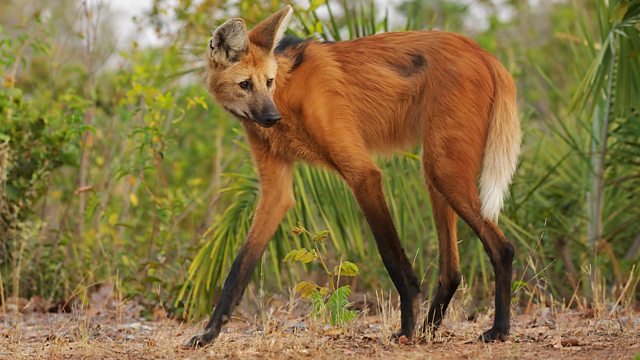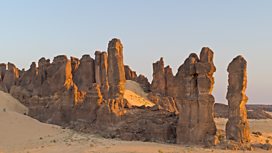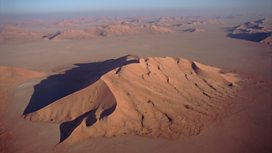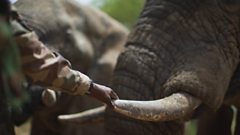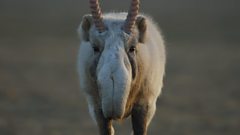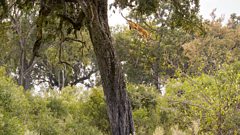Deserts and Grasslands
David Attenborough explores earth’s greatest wildernesses, where extraordinary life survives in unexpected ways, and nature puts on its most dramatic show.
In the baked Namib desert, a pair of ostriches raise their family in the searing heat to keep them safe from predators – but time is ticking as the chicks begin to hatch. Outside of the egg, the newborns won’t survive long in these temperatures, but not all of the clutch hatch at once. For the whole brood to survive, the parents need to time their departure perfectly, but tragically they are forced to leave behind a single unhatched egg. As the family depart, the newborn emerges and the lone chick wanders the vast Namib desert calling for its family.
In the desert, life exists in a world with almost no water, and it drives one troop of desert baboons on a continual quest to find it. A young mother who is low in the pecking order must battle for her right to drink – her newborn’s life depends on it. Without water, her milk will run dry.
As climatic change causes deserts around the world to expand, dust storms towering up to a mile high and travelling at speeds of up to 70mph overwhelm entire cities in an instant.
Where rain falls regularly, it can transform a desert, turning it into one of earth’s most productive landscapes – grasslands. Grasslands support the biggest concentrations of large animals on the planet. This wealth of life, in turn, attracts predators. Leopards are the most adaptable of the big cats, and a handful of special individuals have learned to hunt by hiding and leaping from treetops, some higher than the roof of a two-storey house. Their lives depend on them getting this unique game of hide-and-seek right, and when they do, their prey doesn’t see them coming.
Grasslands are one of the most widespread habitats on earth, and in the frozen north, herds of alien-like saiga antelope fight for their chance to win mating rights. Seventy per cent of rutting males die every year in battles that have been taking place since the ice age.
Closer to the equator, a grassland paradise can be found – the Cerrado in Brazil. This is the richest grassland on earth and home to the rare, fruit-eating maned wolf. Little is known about this bizarre creature, and for the first time, we glimpse inside the den of wild maned wolf. A mother raises her three puppies, but their future is uncertain. The Cerrado is a vitally important grassland – home to thousands of species of plants and animals found nowhere else – and it is in danger of being lost forever. This grassland is being destroyed more than two times faster than the Amazon rainforest to clear land for farming. Reduced to 50 per cent of its former size, some predict it could disappear completely in the next 30 years.
But there is hope. In central Africa, one of the world’s most spectacular wildlife gatherings is testament to what can happen if we help protect these precious ecosystems and allow nature to restore its own balance.
Last on
More episodes
Previous
Next
![]()
In pictures: Deserts and Grasslands
What's in store for this episode about Earth's greatest wildernesses
![]()
How much do you know about Deserts and Grasslands?
Find out by taking this quiz about the show by the C±«Óãtv team
Clips
-
![]()
Wild elephants learn to trust again
Duration: 00:57
-
![]()
The male saiga antelope's large nose
Duration: 01:44
-
![]()
An ostrich eggs hatches minutes too late
Duration: 03:49
-
![]()
Leopard ambushes an antelope from above
Duration: 03:13
Credits
| Role | Contributor |
|---|---|
| Presenter | David Attenborough |
| Production Manager | Bronwen Thomas |
| Executive Producer | Michael Gunton |
| Series Producer | Matt Brandon |
| Series Producer | Jonny Keeling |
| Producer | Kiri Cashell |
Broadcasts
- Sun 5 Nov 2023 18:15
- Sat 11 Nov 2023 15:30±«Óãtv One except Wales & Wales HD
- Boxing Day 2023 06:15
Explore AR animals and their habitats in ‘Habitat Explorer’ or order a poster ‘Our Changing World’ to make origami animals!
Visit The Open University website to learn about fascinating animals in their habitats
